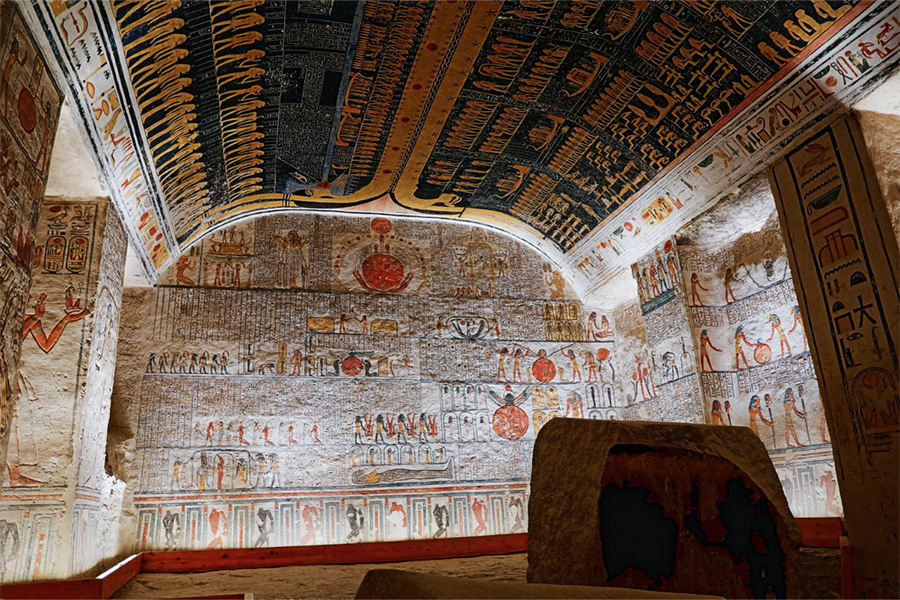Step away from the grandeur of the royal tombs and dive into the lives of ancient Egypt’s elite. The Tombs of the Nobles in Luxor reveal colorful stories of real people—priests, governors, artisans, and scribes—who shaped Egypt’s legacy.

Historical Background
Located on Luxor’s West Bank, near the Valley of the Kings and Queens, the Tombs of the Nobles are often overshadowed by their royal neighbors. But these tombs—carved into the cliffs of Sheikh Abd el-Qurna, el-Asasif, Khoka, and Dra Abu el-Naga—hold some of the best-preserved and most vivid wall paintings in all of Egypt.
Dating from the New Kingdom (c. 1550–1070 BCE) and even earlier, these tombs belonged to high-ranking officials, priests, artisans, and members of the royal court. Unlike the tombs of kings, these places are personal. You’ll see scenes of daily life—banquets, fishing, farming, dancing, and family moments—painted with emotion and color.
Cultural Significance
These tombs serve as intimate windows into the non-royal experience of ancient Egypt. Their detailed inscriptions and vibrant art provide insight into:
They also show how important the afterlife was to everyone, not just the kings. Many tombs were decorated with passages from the Book of the Dead, prayer texts, and offerings to the gods, especially Osiris and Anubis.
🏛️ Must-See Tombs
-
Tomb of Ramose (TT55): A vizier during the reign of Akhenaten—known for a rare blend of classical and Amarna art
-
Tomb of Sennefer (TT96): Famous for its "grapevine ceiling" and cozy feel
-
Tomb of Rekhmire (TT100): Grand and detailed, with scenes of craftsmen, taxation, and tribute from foreign lands
-
Tomb of Nakht (TT52): A scribe and astronomer—his tomb shows rich depictions of music and banquets
-
Tomb of Menna (TT69): Beautifully preserved scenes of agricultural life and afterlife journeys
📍 Visitor Information
Location & Access:
West Bank of Luxor, best accessed by private guide or organized day tour. Often combined with Valley of the Kings or Hatshepsut Temple.
Ticket Information:
Tombs are grouped in sets; prices vary per tomb (typically 80–140 EGP per site). Some combo tickets are available at the West Bank ticket office.
Opening Hours:
Daily from 6:00 AM to 5:00 PM
Best Time to Visit:
Mornings are best to avoid heat and crowds. Weekdays are quieter than weekends.
✨ Unique Experiences
-
Photography Tip:
Lighting inside these tombs is often natural or low, so be ready with a steady hand—or hire a guide who knows the best angles.
-
Spiritual Insight:
Unlike the majestic but distant royal tombs, these feel intimate and alive, offering emotional resonance through personal stories and family connections.
✅ Quick Facts Box
📍 Location: West Bank, Luxor
🕒 Opening Hours: 6 AM – 5 PM
🪦 Known For: Real-life scenes, vibrant colors, non-royal tombs
🎨 Highlight: Tomb of Sennefer’s grapevine ceiling
📝 Best For: Travelers interested in art, everyday life, and untold stories
Conclusion
The Tombs of the Nobles give voice to Egypt’s unsung heroes. Here, history becomes human—and the art still speaks. It’s the perfect complement to a day on Luxor’s West Bank for those looking to go deeper.
Ready to Explore?
Add the Tombs of the Nobles to your West Bank Day Tour with Luxor Booking Tours and step inside the lives of ancient Egypt’s elite.
Links & Further Reading
✈️ Plan your visit: See also our blog on the Valley of the Kings
🌐 Explore more: Theban Tombs Project
Author’s Note
“These tombs are my favorite places to take guests. They're filled with joy, color, and life. You feel like the people who painted them are still whispering their stories.”